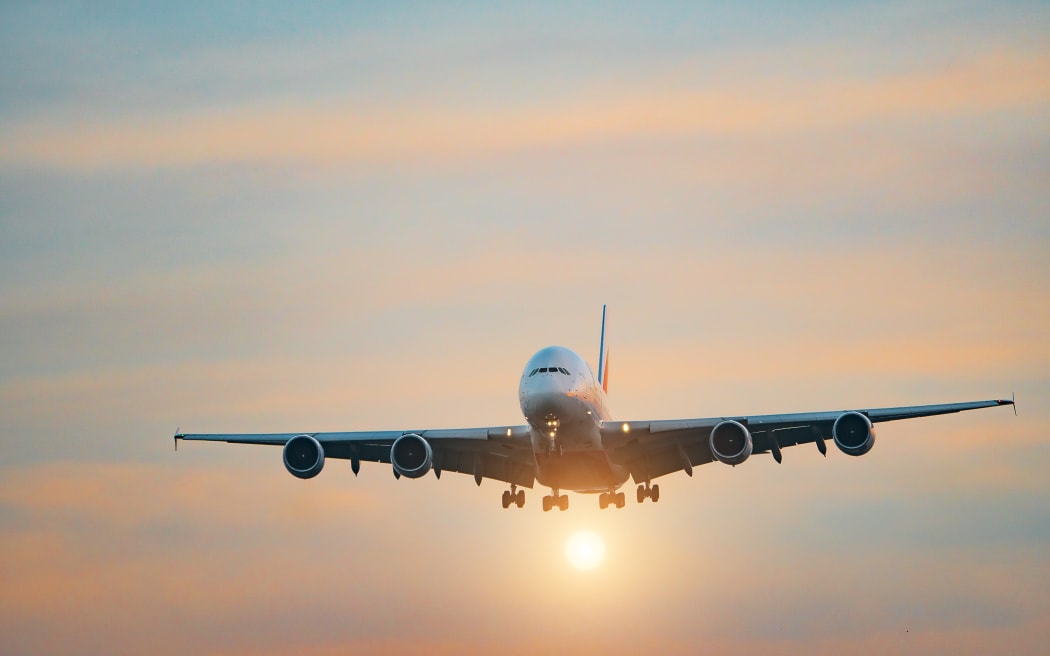Projections by consultants for Channel Infrastructure suggest that from the 2030s, some regional flights will be electric with more added during the 2040s as planes upgraded.
Photo: 123RF
The main transporter of jet fuel to Auckland Airport is expecting booming growth in international flights over the next 25 years, boosted partially by growth in ‘extra long-haul’ journeys.
But a sustainable transport campaigner says that kind of growth would blow New Zealand’s climate targets.
Marsden Point oil refinery used to be one of New Zealand’s biggest greenhouse gas emitters, until it stopped refining in 2022.
Although the new government promised to look at reopening the refinery, chief executive Rob Buchanan said there was no possibility of restarting refining.
“It would require substantial investment, a long period of time and frankly people and folk that no longer work for our business.”
Instead, the facility’s owner, Channel Infrastructure, is planning its future around booming international air travel.
The company supplies 80 percent of New Zealand’s jet fuel, accepting shipments at its jetty at Northport in Northland and piping it 170km to Wiri, near Auckland Airport.
Long-haul travel makes up more than half of the airport’s fuel use, despite being less than a quarter of trips, according to a presentation the company made to investors last year.
Looking ahead to 2050, Channel Infrastructure said New Zealand’s petrol use would plunge to almost zero as almost everyone goes electric, while diesel would also decline, albeit slower, because some of its uses were harder to replace with electricity. Jet fuel use would grow, according to the company’s projections.
The net result may be that planet-heating carbon dioxide emissions generated by fuel carried by the company would be the same or only a little lower in 2050 as today, Buchanan said, though he acknowledged the long-term view was uncertain.
Buchanan said airlines were already adding long-haul routes into New Zealand after pandemic lockdowns, and these used more fuel because of heavier planes.
The company told investors last year growth to 2050 will be driven by more demand from India and Asia and more ‘extra long-haul’ flights, which fly nonstop for over 16 hours to destinations such as New York.
These ‘extra long’ journeys burn more fuel per passenger per kilometre, because of the extra weight of the fuel they carry.
And while Channel Infrastructure is investing in developing synthetic fuel by harnessing renewable energy, neither synthetic nor biofuel (from crops or wood) is expected to be able to keep up with more than a small proportion of the growing demand during the next two decades.
Buchanan noted biofuel was competing with other uses for the feedstock it needs – feeding people, in the case of crops, or cosmetics in the case of tallow.
His company expects electric planes to gradually replace fossil-fuelled ones over shorter routes, but the turnover will happen slowly as planes age out of the fleet. Electric batteries are not expected to be able to cope with long-haul journeys.
Projections by consultants for Channel suggest that from the 2030s, some regional flights will be electric with more added during the 2040s as planes upgraded.
But regional flights are only 6 percent of the demand for jet fuel.
The company’s projections also show a small number of hydrogen flights from the 2040s on both long and short-haul flights, but slow plane turnover means the process of displacing fossil fuel is, again, gradual.
Growth projections ‘plausible’ but problematic – campaigner
Economist-turned-sustainable transport campaigner Dr Paul Callister said Channel’s projections were consistent with others by aviation experts, which show booming demand to 2050, and growth was sustainable biofuel, electric planes failing to compensate.
But to keep global heating in check, most countries have agreed to lower carbon emissions to net zero by 2050.
Callister said if every other part of the economy was lowering its emissions, while aviation was rising, public pressure would force governments to bring in policies to limit demand. He cited projections showing aviation could grow from 5-20 percent of global emissions, if the sector kept growing while other activities decarbonised to reach net zero by 2050.
“If people are roasting and being told they have to e-bike or catch the bus, and yet they’re seeing this huge growth in aviation by the middle class, I think there’s going to be some panic and policy changes.”
Currently, international flights don’t count towards the emissions New Zealand reports on the international stage, or the country’s climate targets, but that could change depending on the outcome of a Climate Change Commission report this year.
Because international flights are not counted in the country’s targets, airlines do not pay a carbon price for their jet fuel used on international journeys, but do pay a cost for carbon dioxide produced on domestic journeys.
Air NZ, which voluntarily reports its jet fuel emissions, makes around 3.4 million tonnes of carbon dioxide from burning jet fuel, mainly for international travel – the equivalent of around a twentieth of the country’s emissions. It wants to get that impact down with electric short-haul planes and sustainable fuel.
>>> Read full article>>>
Copyright for syndicated content belongs to the linked Source : RNZ – https://www.rnz.co.nz/news/business/506701/extra-long-haul-flights-boom-would-blow-climate-targets-campaigner-says






















![Forest ecology cannot be reduced to arithmetic, says M.I. Varghese [Interview] – Mongabay-India](https://earth-news.info/wp-content/uploads/2025/12/328946-forest-ecology-cannot-be-reduced-to-arithmetic-says-mi-varghese-interview-mongabay-india-120x86.jpg)









